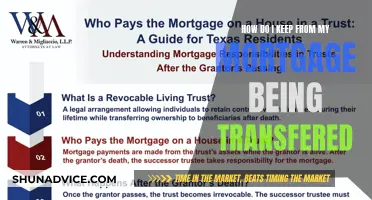
Choosing the right mortgage is a huge financial decision that requires careful consideration of your needs and budget. The two main parts of a mortgage payment are the principal, which is the loan amount, and the interest charged on that principal. It's important to understand the different types of mortgages available, such as fixed-rate or adjustable-rate mortgages, and to shop around for the best deal. You should also consider the loan term, which can range from 10 to 30 years, and whether you qualify for any special programs, such as VA or FHA loans. Additionally, you need to be mindful of the risks associated with certain types of mortgages and ensure that you can afford the monthly payments.
| Characteristics | Values |
|---|---|
| Affordability | Know how much you can afford and shop for bargains |
| Interest rates | Fixed or adjustable |
| Loan term | 10, 15, or 30-year terms |
| Down payment | The amount of down payment determines the details of the loan |
| Risk | Consider the amount of risk you are willing to take |
| Total cost | Consider the overall cost of the loan, not just the monthly payment |
| Refinancing | Refinancing can be beneficial but is not guaranteed |
| Lender credits | Rebates from the lender that offset closing costs in exchange for a higher interest rate |
| Points | Upfront charges paid to the lender in exchange for a lower interest rate |
| Number of quotes | Getting more than one quote can help you save |
What You'll Learn

Fixed-rate mortgages
The most common fixed-rate mortgage is the 30-year option, with about nine in 10 homebuyers opting for this type of loan. However, shorter-term loans are also available, with 15-year fixed-rate mortgages being the second most popular choice. While a shorter-term loan will result in higher monthly payments, you will see a significant reduction in the total interest expense over the life of the mortgage. Additionally, shorter-term loans often come with better mortgage rates.
However, it's important to consider the potential drawbacks of fixed-rate mortgages. Firstly, while your interest rate won't increase, it also won't decrease if market interest rates fall. This means that you could end up paying more in interest than you would with an ARM. Additionally, fixed-rate mortgages typically have stricter requirements than other types of loans, such as a minimum credit score and a maximum debt-to-income ratio.
Finding Mortgage Origination Fees: What You Need to Know
You may want to see also

Adjustable-rate mortgages
An adjustable-rate mortgage (ARM) is a home loan with a variable interest rate. This means that the interest rate on an ARM will change periodically, unlike a fixed-rate mortgage, where the interest rate remains the same for the life of the loan. The initial interest rate of an ARM is usually fixed for a certain period of time, ranging from 3 to 10 years, and is typically lower than that of a fixed-rate mortgage. After the initial fixed-rate period, the interest rate on an ARM will adjust at yearly or monthly intervals based on changes in a corresponding financial index, such as the Secured Overnight Financing Rate (SOFR) or the U.S. Treasury-Index (T-Bill).
The variable nature of an ARM means that your monthly payments may increase or decrease depending on the movement of the interest rate index. Most ARMs have caps in place to limit how much the interest rate and monthly payments can rise per year or over the lifetime of the loan, providing some protection from significant interest rate swings. Additionally, the initial borrowing costs of an ARM are typically lower than those of a fixed-rate mortgage, making it a more affordable option for homebuyers.
An ARM may be a suitable option for homebuyers who plan to keep the loan for a limited period, such as those who expect to move, refinance, or pay off the mortgage within a few years. It can also be a good choice for those seeking lower initial monthly payments and those who believe their future earnings will increase. However, it's important to consider your risk appetite and financial situation before opting for an ARM, as there is a possibility of a major payment jump in the future if interest rates rise.
There are different types of ARMs available, including hybrid ARMs, interest-only ARMs, and payment option ARMs. Hybrid ARMs offer a mix of a fixed- and adjustable-rate period, with the interest rate remaining fixed for the initial period and then adjusting at predetermined intervals. Interest-only ARMs allow borrowers to pay only the interest for a specified period, after which they begin paying down the principal. Payment option ARMs provide borrowers with flexible payment options, including the ability to make minimum, interest-only, or fully amortized payments.
When considering an ARM, it's important to shop around and compare offers from multiple lenders. The interest rate caps, initial interest rate period, and underlying benchmark index may vary between lenders, so it's crucial to understand the specific terms and conditions of the ARM before making a decision. Additionally, it's worth noting that ARMs are not suitable for everyone, and a fixed-rate mortgage may be preferable for those seeking long-term stability and peace of mind regarding their monthly payments.
Who Owns My Mortgage? Finding Your Mortgage Investor
You may want to see also

Loan types and lenders
The two main parts of a mortgage payment are the principal, which is the loan amount, and the interest charged on that principal. The interest rate determines how much interest you owe each month, and you also need to know what your total mortgage payment will be each month. This is sometimes called PITI and may include private mortgage insurance (PMI).
There are six main types of mortgages: conventional, conforming, nonconforming, FHA-insured, VA-insured, and USDA-insured. Some loans have fixed interest rates, while others have adjustable rates that change over time.
Fixed-rate mortgages
With a fixed-rate mortgage (FRM), you won't have to worry about the interest rate changing at all throughout the loan period, which means your monthly payment won't increase. However, you may pay a higher price for this peace of mind.
Adjustable-rate mortgages
Adjustable-rate mortgages (ARMs) usually start with a lower interest rate than fixed-rate mortgages, but this can fluctuate over time, causing your monthly payments to increase. ARMs are therefore a good option if you are certain you will move, refinance, or pay off the mortgage before the guaranteed rate expires.
FHA loans
FHA loans are best for low- to moderate-income borrowers who can't qualify for a conventional loan or afford a significant down payment. Borrowers with a FICO score as low as 500 can qualify for a 10% down payment, and those with scores of 580 or above may qualify for a 3.5% down payment. FHA loans are also an option for repeat borrowers as long as they are buying a primary residence and meet the other requirements.
VA loans
The US Department of Veterans Affairs (VA) guarantees mortgages for qualified military service members, veterans, and their spouses.
USDA loans
USDA loans are for those who want to live in a rural or suburban area.
When choosing a mortgage, it's important to shop around and compare terms from different lenders. You can use a Loan Estimate to compare costs across different lenders. It's a good idea to know what kind of loan you want before requesting Loan Estimates so you can compare offers more easily.
Generate Mortgage Leads: Strategies for Success
You may want to see also

Affordability
The down payment you can afford will also determine the details of the loan you qualify for. A higher down payment will generally result in a lower interest rate and monthly payment. You should also consider the overall cost of the loan, as some loans with lower monthly payments may have a higher total cost.
There are a few options for loans with lower down payments. FHA loans are best for low- to moderate-income borrowers who cannot qualify for a conventional loan or afford a significant down payment. Borrowers with a FICO score of 500 can qualify for a 10% down payment, and those with scores of 580 or above may qualify for a 3.5% down payment. VA loans are another option, with the US Department of Veterans Affairs guaranteeing mortgages for qualified military service members, veterans, and their spouses.
It is also important to consider the interest rate on the loan. A fixed-rate mortgage will have the same interest rate for the entire term of the loan, while an adjustable-rate mortgage (ARM) will have an interest rate that changes periodically, which can result in a higher monthly payment. A fixed-rate mortgage may be a better option if you are certain you will stay in the home for a long time, as you won't have to worry about the interest rate increasing. However, an ARM may be a good choice if you plan to move, refinance, or pay off the mortgage within a certain period, as they often have lower initial interest rates.
You should also be aware of negative amortization, where you only pay a portion of the interest each month, and the unpaid interest is added to the principal. This can be risky, as you may end up owing more on the home than it is worth.
It is recommended to get quotes from multiple lenders and compare their rates and fees to find the best deal. You can also use a mortgage calculator to estimate your total monthly payment and closing costs.
Discovering Your Original Mortgage Amount: A Simple Guide
You may want to see also

Risk
Choosing the right mortgage is a huge financial decision that requires careful consideration of your personal risk appetite. The two main types of mortgages are fixed-rate mortgages (FRM) and adjustable-rate mortgages (ARM), each presenting varying levels of risk.
With a fixed-rate mortgage, you lock in an interest rate for the entire duration of the loan, providing peace of mind and stability as your monthly payments remain constant. This option is ideal if you're risk-averse and want to avoid potential increases in your monthly payments. However, it's important to note that FRMs typically come with slightly higher interest rates compared to ARMs.
On the other hand, adjustable-rate mortgages (ARMs) offer lower initial interest rates, making them attractive if you're open to some risk or planning a short stay in the property. The interest rate on an ARM is usually fixed for a certain period, after which it becomes adjustable and can fluctuate up or down. This means your monthly payments may increase or decrease, depending on the market conditions. If you plan to move, refinance, or pay off the mortgage before the guaranteed rate expires, an ARM can be a good option, allowing you to save thousands of dollars in interest during the initial rate period.
Additionally, there are hybrid ARMs, which are a common type of ARM nowadays. These loans are fixed for a specific period before becoming adjustable. For example, a 5/1 ARM has a fixed rate for the first five years, and then the rate adjusts annually for the remaining term.
Another aspect to consider is the length of the mortgage. While 30-year mortgages are common, there are also shorter options, such as 15-year and 10-year loans. Opting for a shorter-term loan can lead to a significant reduction in the total interest expense over the life of the mortgage and may provide you with a better mortgage rate.
Furthermore, certain loans, such as negative amortization loans, can be risky. In this type of loan, you only pay a portion of the interest each month, and the unpaid interest is added to the principal, causing your loan balance to increase over time. This can result in you owing more on your home than its potential selling price.
Lastly, it's worth noting that your credit score and history can impact the mortgage options available to you. FHA loans, for instance, cater to low- to moderate-income borrowers who may not qualify for conventional loans or afford a substantial down payment.
In conclusion, when considering the risk associated with mortgages, evaluate your financial situation, risk tolerance, and plans for the property. Assess the potential fluctuations in interest rates and how they may impact your monthly payments, especially with adjustable-rate mortgages. Remember to shop around, compare offers from multiple lenders, and carefully consider the terms to make an informed decision that aligns with your financial goals.
Understanding Subprime Mortgages: Am I at Risk?
You may want to see also
Frequently asked questions
There are several factors to consider when choosing a mortgage. Firstly, you need to know how much you can afford to borrow and what you can afford to pay back each month. You should also consider the amount of risk you are willing to take on, as some mortgages with lower monthly payments may have a higher overall cost. It's important to do your research and compare the options available to make the right decision.
The two main types of mortgages are fixed-rate mortgages and adjustable-rate mortgages (ARM). With a fixed-rate mortgage, your interest rate stays the same throughout the loan period, whereas with an ARM, your interest rate may fluctuate. There are also special types of loans for first-time buyers, military personnel, those with lower credit scores, and those looking to buy property in rural or suburban areas.
This depends on your financial situation and personal preferences. If you are risk-averse, a fixed-rate mortgage may be preferable as it provides peace of mind regarding monthly payments. However, if you are open to risk and plan to stay in the property for a shorter period, an ARM could be a good option as it often has lower initial payments.
Shopping for a mortgage is similar to shopping for other large purchases. You should get multiple quotes from different lenders, compare the terms, and negotiate to get the best deal. It's important to review the loan estimates carefully and consider the overall cost, including interest rates, closing costs, and any additional fees.







